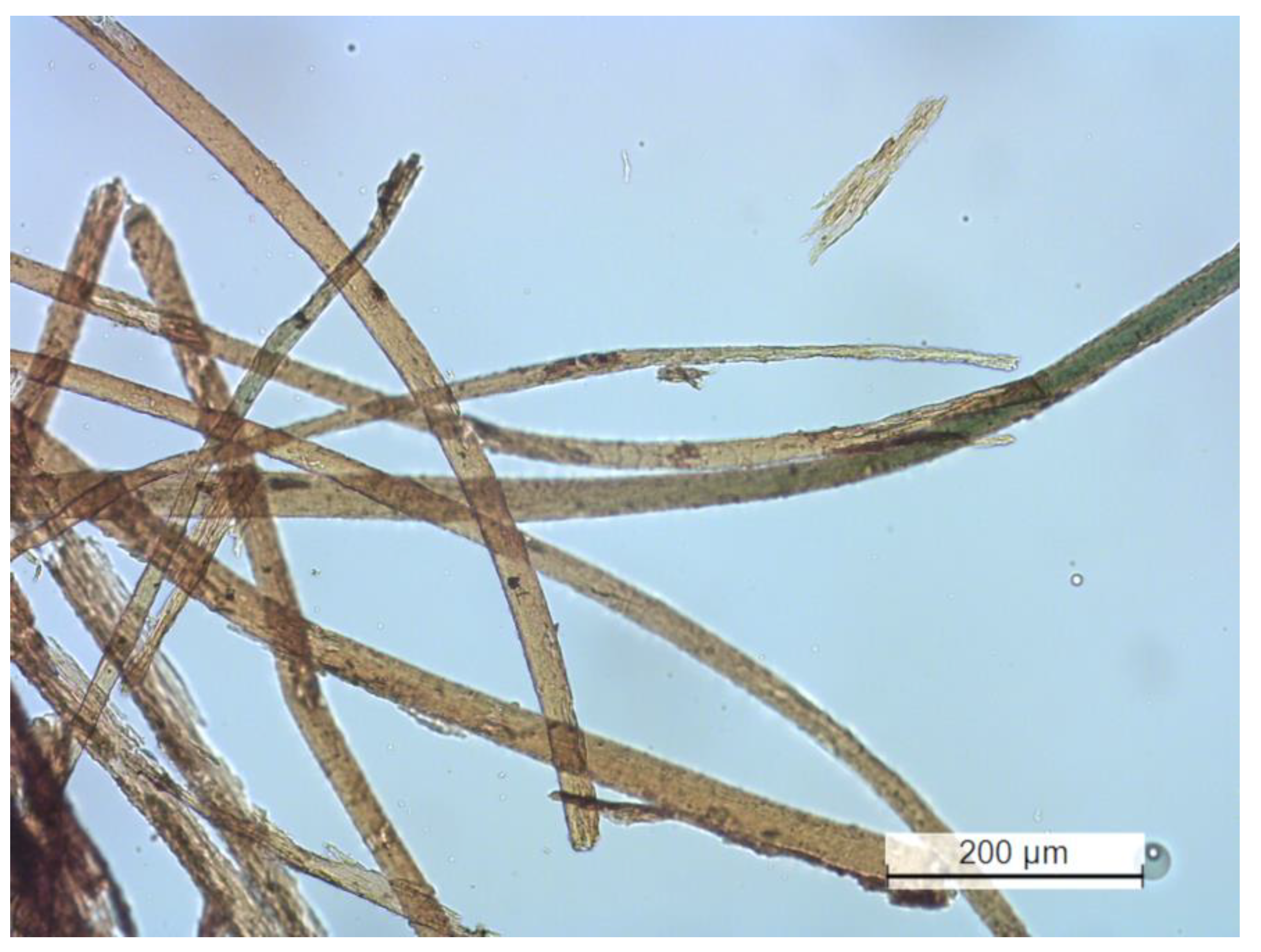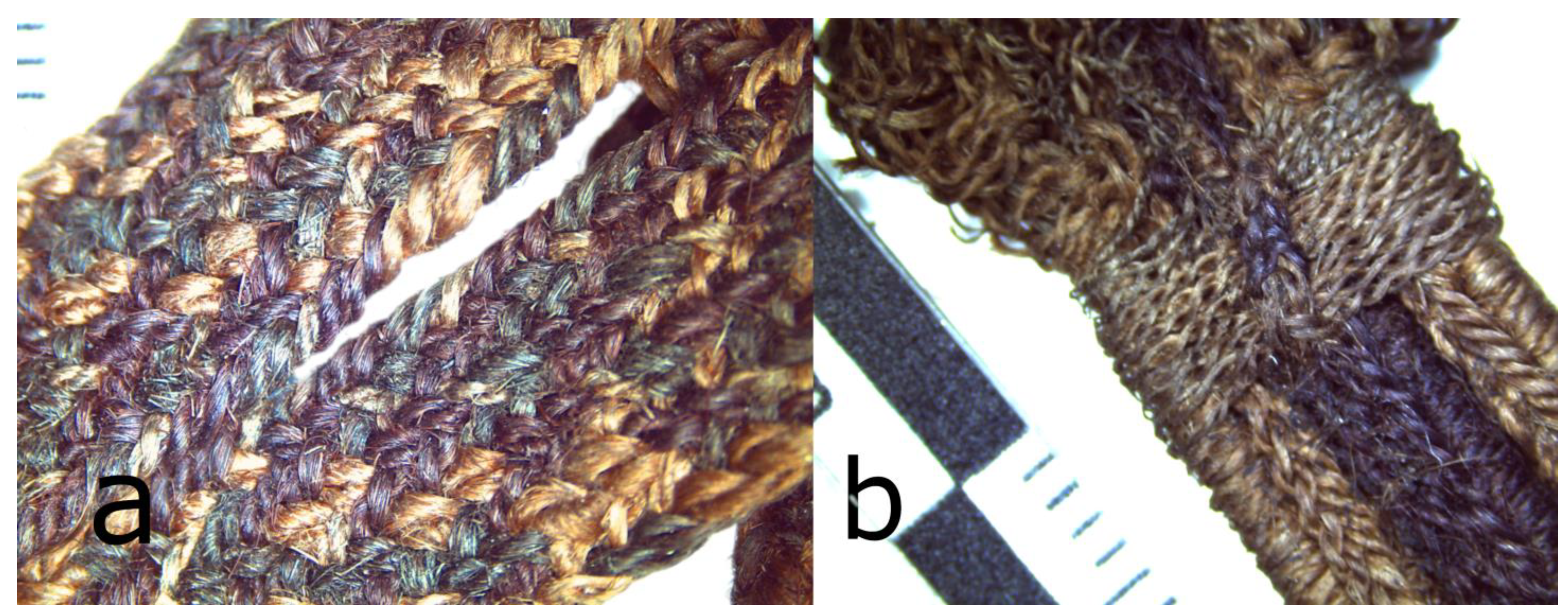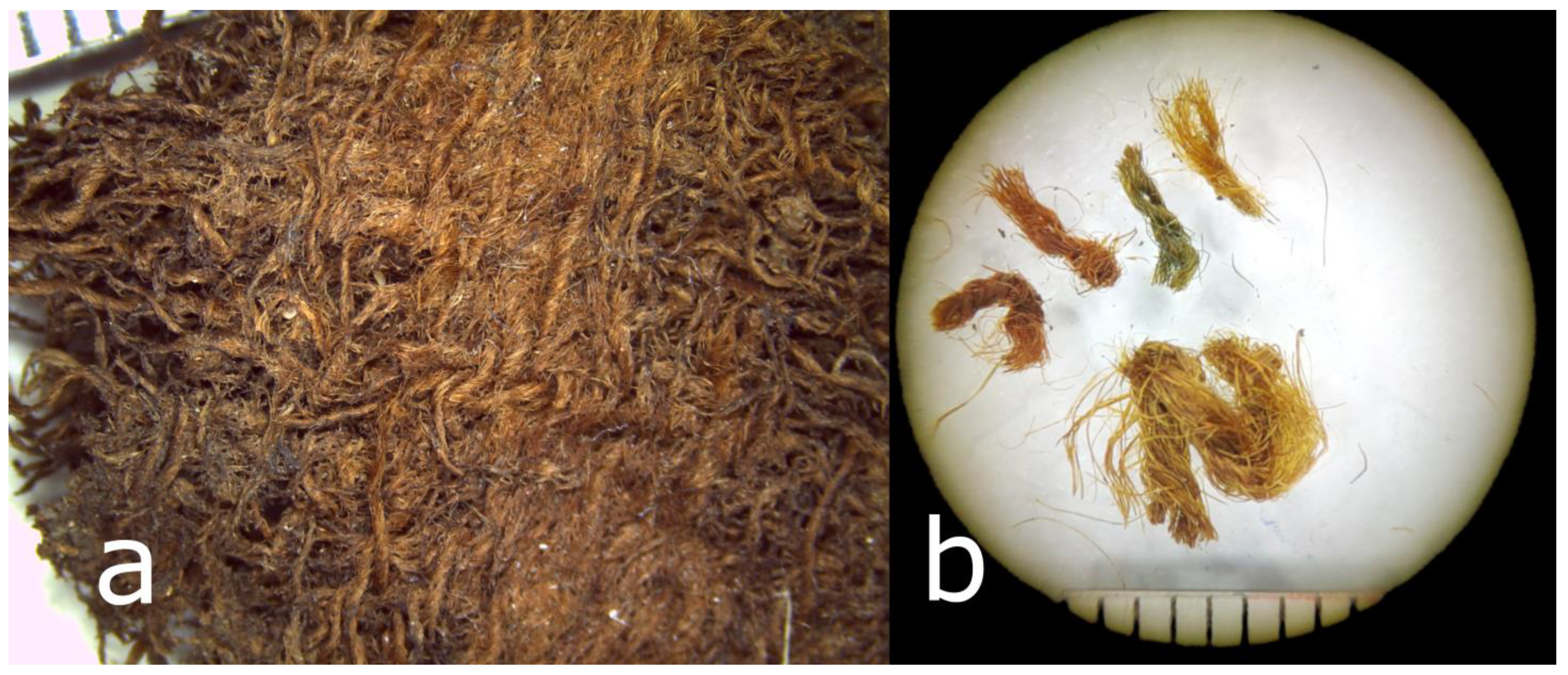Colorants Detected by HPLC-PDA in Textiles from 13th Century Lieto Ristinpelto, Finland
Abstract
1. Introduction
2. Archaeological Background
3. Materials and Methods
3.1. Archaeological Materials
3.2. Dye Extraction
3.3. Chromatography
4. Results
4.1. Indigoids for Blue
4.2. Orange Compounds
4.3. Anthraquinones for Red
4.4. Yellow Colorants
4.5. Other Compounds
5. Discussion
6. Conclusions
Author Contributions
Funding
Institutional Review Board Statement
Informed Consent Statement
Data Availability Statement
Acknowledgments
Conflicts of Interest
Ethics
References
- Vanden Berghe, I.; Gleba, M.; Mannering, U. Towards the identification of dyestuffs in Early Iron Age Scandinavian peat bog textiles. J. Archaeol. Sci. 2009, 36, 1910–1921. [Google Scholar] [CrossRef]
- Hofmann-de Keijzer, R.; van Bommel, M.R.; Joosten, I. Dyestuff and element analysis on Textiles from the prehistoric Salt-mines of Hallstatt. In Hallstatt Textiles. Technical Analysis, Scientific Investigation and Experiment on Iron Age Textiles; Bichler, P., Grömer, K., Hofmann-de Keijzer, R., Kern, A., Reschreiter, H., Eds.; BAR International Series 1351; Archaeopress: Oxford, UK, 2005; pp. 91–96. [Google Scholar]
- Karapanagiotis, I.; Mantzouris, D.; Cooksey, C.; Mubarak, M.S.; Tsiamyrtzis, P. An improved HPLC method coupled to PCA for the identification of Tyrian purple in archaeological and historical samples. Microchem. J. 2013, 110, 70–80. [Google Scholar] [CrossRef]
- Vanden Berghe, I.; (IRPA/KIK, Royal Institute for Cultural Heritage, Brussels, Belgium). Collaborative Study about Finnish Dye Sources and Local Recipes. Organic Colourant Analysis. Unpublished work. 2012. [Google Scholar]
- Proaño Gaibor, A.N.; (The Cultural Heritage Agency of the Netherlands, Amersfoort, Utrecht, The Netherlands). Unpublished work. 2011.
- Tomanterä, L. Muinaispukurekonstruktio Maskun Humikkalan haudasta 32. In Ken kantaa Kalevalaa: 1835 Kalevala 1985. Exhibition Catalogue of National Board of Antiquities and Kalevala Jewelry; Purhonen, P., Söyrinki-Harmo, L., Tomanterä, L., Aav, M., Masala, S.-R., Johansson, M., Eds.; Kalevala Koru: Helsinki, Finland, 1984; pp. 35–49. [Google Scholar]
- Lehtosalo-Hilander, P.-L. Ancient Finnish Costumes; Suomen Arkeologinen Seura: Helsinki, Finland, 1984. [Google Scholar]
- Lehtosalo-Hilander, P.-L. Euran Puku ja Muut Muinaisvaatteet; Euran Muinaispukutoimikunta: Eura, Finland, 2001. [Google Scholar]
- Riikonen, J. Naisenhauta Kaarinan Kirkkomäessä; Karhunhammas 12; Turun yliopisto: Turku, Finland, 1990. [Google Scholar]
- Wikström, L.; (Valtion Teknillinen Tutkimuskeskus, Tekstiililaboratorio, Helsinki, Finland); Sundquist, J.; (Valtion Teknillinen Tutkimuskeskus, Tekstiililaboratorio, Helsinki, Finland); Enebäck, U.; (Valtion Teknillinen Tutkimuskeskus, Tekstiililaboratorio, Helsinki, Finland); Kahlson, C.; (Valtion Teknillinen Tutkimuskeskus, Tekstiililaboratorio, Helsinki, Finland). Unpublished work. 1972.
- Lehtosalo-Hilander, P.-L.; Sarkki, S.; Tomanterä, L. Euran Puku ja sen Edeltäjät; Euran Muinaispukutoimikunta: Eura, Finland, 1982. [Google Scholar]
- Riikonen, J. A message of dress from Finland Proper: A Viking Age grave and costume reconstruction. In Arheoloogia Läänemeremaades: Uurimusi Jüri Seliranna Auks; Lang, V., Tamla, U., Eds.; Ajaloo Instituut: Tallin, Estonia, 2003; pp. 229–249. [Google Scholar]
- Riikonen, J. Arkeologiset tekstiililöydöt—tutkimusta ja tulkintaa. In Sinihameet—Kultavyöt: Suomalaisia Muinaispukuja; Luoma, H., Ed.; Taito-Pirkanmaa: Tampere, Finland, 2006; pp. 6–35. [Google Scholar]
- Walton, P.; (Textile Research in Archaeology, York, UK). Report on Tests for Dye in Textiles from Late Medieval Turku. Unpublished work. 2001. [Google Scholar]
- Walton, P.; (The Anglo-Saxon Laboratory, York, UK). Unpublished work. 2004.
- Kirjavainen, H.; Riikonen, J. Tekstiilien valmistuksesta Turussa myöhäisrautakaudella ja keskiajalla. Muinaistutkija 2005, 3, 30–44. [Google Scholar]
- van Bommel, M.; (The Cultural Heritage Agency of the Netherlands, Amersfoort, Utrecht, The Netherlands); Proaño Gaibor, A.N.; (The Cultural Heritage Agency of the Netherlands, Amersfoort, Utrecht, The Netherlands). Unpublished work. 2012.
- van Bommel, M.; (The Cultural Heritage Agency of the Netherlands, Amersfoort, Utrecht, The Netherlands); Joosten, I.; (The Cultural Heritage Agency of the Netherlands, Amersfoort, Utrecht, The Netherlands). Unpublished work. 2013.
- Vajanto, K.; van Bommel, M.R. Dyed Textiles from Late Iron Age Finland. Fennosc. Archaeol. 2014, 61–78. [Google Scholar]
- Vajanto, K. Dyes and Dyeing Methods in Late Iron Age Finland. Doctoral Dissertation, University of Helsinki, Helsinki, Finland, 2015. [Google Scholar]
- Kirkinen, T.; Arponen, A.; Vanden Berghe, I. Globalization and tradition in Forest Sámi commemoration rituals. Textiles and animal skins in the 17-th century burial ground in Mukkala, eastern Lapland, Finland. In Helsinki Harvest, Proceedings of the 11th on the Nordic Conference on the Application of Scientific Methods in Archaeology; Mannermaa, K., Manninen, M.A., Pesonen, P., Seppänen, L., Eds.; Monographs of the Archaeological Society of Finland; Archaeological Society of Finland: Helsinki, Finland, 2015; pp. 178–195. Available online: http://www.sarks.fi/masf/masf_7/masf_7.html (accessed on 5 December 2022).
- Vanden Berghe, I.; (IRPA/KIK, Royal Institute for Cultural Heritage, Brussels, Belgium). Unpublished work. 2012.
- Vanden Berghe, I.; (IRPA/KIK, Royal Institute for Cultural Heritage, Brussels, Belgium). Unpublished work. 2013.
- Kirjavainen, H. The Dress of a Saint? A Medieval Textile Find from Turku Cathedral. Mirator 2015, 16, 324–336. [Google Scholar]
- Arponen, A.; Vanden Berghe, I.; Kinnunen, J. Red fabrics in the Relic Assemblage of Turku Cathedral. Available online: https://www.researchgate.net/publication/338572417_Red_Fabrics_in_the_Relic_Assemblage_of_Turku_Cathedral_Proceedings_of_the_1st_International_Meeting_RelicsThe_Lab_An_Analytical_Approach_to_the_Study_of_Relics_27-28_Oct_2016_Interdisciplinary_Studies (accessed on 5 December 2022).
- Wright, K.; Pasanen, M.; Sojonen, E. Recreation of the medieval intarsia textile from Masku church, Finland. In Interdisciplinary Approaches to Textile Research: Northern and Central European Textile Production and Use of Textiles and Clothing from the Neolithic to the Modern Period, Proceedings of the NESAT XIV, The North European Symposium for Archaeological Textiles, Oulu, Finland, 23–26 August 2020; Lipkin, S., Wright, K., Ruhl, E., Eds.; Monographs of the Archaeological Society of Finland; Archaeological Society of Finland: Helsinki, Finland, 2023; in print. [Google Scholar]
- Lipkin, S.; Vajanto, K.; Kallio-Seppä, T.; Kuokkanen, T.; Niinimäki, S.; Väre, T.; Bommel, M.R. Funeral Dress and Textiles in 17th and 19th Century Burials in Ostrobothnia, Finland. In Aspects of the Design, Production and Use of Textiles and Clothing from the Bronze Age to the Early Modern Era, Proceedings of the NESAT XII, The North European Symposium of Archaeological Textiles; Archaeolingua Alapítvány: Budapest, Hungary, 2015; pp. 209–221. [Google Scholar]
- Riikonen, J.; Ruohonen, J. Hihansuusta säärisiteisiin: Palasia Ravattulan Ristimäen tekstiililöydöistä. Hiisi 2016, 2, 20–27. [Google Scholar]
- Karisto, M.; Kirjavainen, H.; Riikonen, J.; Ruohonen, J. Ravattula Costume. The Study of the Grave Find; Suomen Muinaistutkimuksen Tuki ry: Turku, Finland, 2020. [Google Scholar]
- Kirjavainen, H. Medieval archaeological textiles in Turku. In Centre, Region, Periphery, 3rd. International Conference of Medieval and Later Archaeology; Helming, G., Scholkmann, B., Untermann, M., Eds.; Verlag Dr. G. Wesselkamp: Hertingen, Germany, 2002; pp. 346–351. [Google Scholar]
- Kirjavainen, H. Medieval archaeological textiles found in Turku, Finland. Archaeol. Text. Newsl. 2003, 36, 12–19. [Google Scholar]
- Kirjavainen, H.; Riikonen, J. Changing textile crafts in Turku, SW Finland: Following traditions and adopting innovations. In Art and Crafts in Medieval Rural Environment; Klápšte, J., Sommer, P., Eds.; Brepols Publishers: Turnhout, Belgium, 2007; Volume 6, pp. 167–174. [Google Scholar] [CrossRef]
- Sarkki, S. Suomen Ristiretkiaikaiset Nauhat; Helsingin Yliopisto: Helsinki, Finland, 1979. [Google Scholar]
- Tandem Laboratory Uppsala; (Uppsala University, Uppsala, Sweden). Unpublished work. 2022.
- Hiekkanen, M. Burial Practices in Finland from Bronze Age to the Early Middle Ages. In Från Hedniskt till Kristet: Förändringar i Begravningsbruk Och Gravskick i Skandinavien ca. 800–1200; Nilsson, B., Ed.; Runica et mediævalia, Opuscula; Sällskapet Runica et Mediævalia: Stockholm, Sweden, 2010; pp. 271–379. [Google Scholar]
- Cleve, N. En kyrkogård från korstågstiden. In Corolla Archaeologica in Honorem; Nordman, C.A., Kivikoski, E., Eds.; Suomen Muinaismuistoyhdistys: Helsinki, Finland, 1952; pp. 159–167. [Google Scholar]
- Ruohonen, J. Ristimäki in Ravattula: On the Remains of the Oldest Known Church in Finland. In New Visits to Old Churches: Sacred Monuments and Practices in the Baltic Sea Region; Harjula, J., Hukantaival, S., Immonen, V., Randla, A., Ratilainen, T., Eds.; Cambridge Scholars Publishing: Newcastle upon Tyne, UK, 2017; pp. 46–60. [Google Scholar]
- Rast-Eicher, A. Bast before wool: The first textiles. In Hallstatt Textiles: Technical Analysis, Scientific Investigation and Experiment on Iron Age Textiles; Bichler, P., Grömer, K., Hofmann-de Keijzer, R., Kern, A., Reschreiter, H., Eds.; BAR International Series 1351; Archaeopress: Oxford, UK, 2005; pp. 117–132. [Google Scholar]
- Suomela, J.A.; Vajanto, K.; Räisänen, R. Seeking Nettle Textiles—Utilizing a Combination of Microscopic Methods for Fibre Identification. Stud. Conserv. 2018, 63, 412–422. [Google Scholar] [CrossRef]
- Haugan, E.; Holst, B. Determining the fibrillary orientation of bast fibres with polarized light microscopy: The modified Herzog test (red plate test) explained. J. Microsc. 2013, 252, 159–168. [Google Scholar] [CrossRef] [PubMed]
- SFS-EN ISO 20706–1:2019; Textiles. Qualitative and Quantitative Analysis of Some Bast Fibres (Flax, Hemp, Ramie) and Their Blends. Part 1: Fibre Identification Using Microscopy Methods. Finnish Standards Association SFS: Helsinki, Finland, 2019.
- Bergfjord, C.; Holst, B. A procedure for identifying textile bast fibres using microscopy: Flax, nettle/ramie, hemp and jute. Ultramicroscopy 2010, 110, 1192–1197. [Google Scholar] [CrossRef] [PubMed]
- Karisto, M.; Pasanen, M. Tablet Woven Treasures. Archaeological Bands from the Finnish Iron Age; Salakirjat, Tallinna Raamatutrükikoda: Tallinn, Estonia, 2021. [Google Scholar]
- Appelgren-Kivalo, H. Suomalaisia Pukuja Myöhemmältä Rautakaudelta—Finnische Trachten aus der Jüngeren Eisenzeit; Oy Weilin & Göös Ab: Helsinki, Finland, 1907. [Google Scholar]
- Vanden Berghe, I.; (IRPA/KIK, Royal Institute for Cultural Heritage, Brussels, Belgium); Coudray, A.; (IRPA/KIK, Royal Institute for Cultural Heritage, Brussels, Belgium). Lieto Ristinpelto, Female Burial 86—Finnish Late Iron Age. Unpublished work. 2022. [Google Scholar]
- Cardon, D. Natural Dyes. Sources, Tradition, Technology and Science; Archetype Publications: London, UK, 2007. [Google Scholar]
- Hofmann-de Keijzer, R.; van Bommel, M.R.; Joosten, I.; Hartl, A.; Proaño Gaibor, A.N.; Heiss, A.G.; Kralofsky, R.; Erlach, R.; de Groot, S. The colours and dyeing techniques of prehistoric textiles from salt mines of Hallstatt. In Textiles from Hallstatt, Weaving Culture in Bronze Age and Iron Age Salt Mines/Textilen aus dem Bronze- und Eisenzeitlichen Salzbergwerk; Grömer, K., Kern, A., Reschreiter, H., Rösel-Mautendorfer, H., Eds.; Archaeolingua: Budapest, Hungary, 2013; pp. 135–162. [Google Scholar]
- Rammo, R.; Wright, K.; Pasanen, M. Searching for mastery in dyeing: Blackish blue on Estonian and Finnish textile finds from the 11th–15th centuries. In Interdisciplinary Approaches to Textile Research: Northern and Central European Textile Production and Use of Textiles and Clothing from the Neolithic to the Modern Period, Proceedings of the NESAT XIV, The North European Symposium for Archaeological Textiles, Oulu, Finland, 23–26 August 2020; Lipkin, S., Wright, K., Ruhl, E., Eds.; Monographs of the Archaeological Society of Finland; Archaeological Society of Finland: Helsinki, Finland, 2023; in print. [Google Scholar]
- Vanden Berghe, I.; (IRPA/KIK, Royal Institute for Cultural Heritage, Brussels, Belgium); Coudray, A.; (IRPA/KIK, Royal Institute for Cultural Heritage, Brussels, Belgium). Unpublished work. 2019.
- Tomanterä, L. Tekstiililöytö—Muinaispuku. In Studia Minora: Professori Carolo Fredrico Meinander Die Caroli MCMLXXXII Gratia Dedicaverunt Discipuli; Edgren, H., Uino, P., Eds.; Helsingin Yliopisto: Helsinki, Finland, 1982; pp. 157–165. [Google Scholar]
- Riikonen, J. 2005. Iron Age aprons from southwestern Finland. In Rituals and Relations: Studies on the Material Culture of the Baltic Finns; Mäntylä, S., Ed.; Annales Academiae Scientiarum Fennicae, Humaniora 336; Finnish Academy of Science and Letters: Helsinki, Finland, 2005; pp. 31–72. [Google Scholar]
- Vanden Berghe, I.; (IRPA/KIK, Royal Institute for Cultural Heritage, Brussels, Belgium); Coudray, A.; (IRPA/KIK, Royal Institute for Cultural Heritage, Brussels, Belgium); Humikkala, M.; (IRPA/KIK, Royal Institute for Cultural Heritage, Brussels, Belgium). Unpublished work. 2022.
- Chenciner, R. Madder Red. A History of Luxury and Trade. Plant Dyes and Pigments in World Commerce and Art; Routledge Curzon: London, UK; New York, NY, USA, 2000. [Google Scholar]
- Rammo, R.; Matsin, A. Textile production in a medieval village in Siksälä, Estonia. In Aspects of the Design, Production and Use of Textiles and Clothing from the Bronze Age to the Early Modern Era, Proceedings of the NESAT XII. The North European Symposium of Archaeological Textiles, Hallstatt, Austria, 21–24 May 2014; Grömer, K., Pritchard, F., Eds.; Archaeolingua Main Series 33; Archaeolingua: Budapest, Hungary, 2015; pp. 185–194. [Google Scholar]
- Walton, P. Dyes and wools in Iron Age textiles from Norway and Denmark. J. Dan. Archaeol. 1988, 7, 144–158. [Google Scholar] [CrossRef]
- Nockert, M. The Högom Find and the Other Migration Period Textiles and Costumes in Scandinavia. Doctoral Dissertation, University of Umeå, Umeå, Sweden, 1991. [Google Scholar]
- Vanden Berghe, I.; Mannering, U.; Rimstad, C.; Coudray., A. New dye analyses of Danish Viking Age textiles from the Bjerringhøj and Hvilehøj graves and the Hedeby harbour. J. Archaeol. Sci. Rep. 2021. in print. [Google Scholar]
- Walton, P.; (Textile Research in Archaeology, York, UK). Report on Tests for Dye in Textiles from Grave 27 at St. Katherine’s Church Hill. Unpublished work. 2001. [Google Scholar]
- Vajanto, K. Nålbinding in prehistoric burials—Reinterpreting Finnish the 11th–14th century fragments. In Sounds Like Theory, XII Nordic Theoretical Archaeology Group Meeting, Oulu, Finland, 25–28 April 2012; Ikäheimo, J., Ed.; Monographs of the Archaeological Society of Finland, MASF 2; Archaeological Society of Finland: Helsinki, Finland, 2014; pp. 21–33. Available online: http://www.sarks.fi/masf/masf_2/masf_2.html (accessed on 5 December 2022).
- Seppänen, L. Turun kaupungin perustaminen. In Pitkin Poikin Aurajokea: Arkeologisia Tutkimuksia; Ratilainen, T., Hukantaival, S., Mustonen, R., Ratilainen, T., Eds.; Turun museokeskus: Raportteja, Turku, 2019; pp. 81–96. [Google Scholar]
- Schweppe, H. Handbuch der Naturfarbstoffe, Vorkommen, Verwendung, Nachweis; Nikol Verlagsgesellschaft mbH & Co.: Hamburg, Germany, 1993. [Google Scholar]
- Vanden Berghe, I.; (IRPA/KIK, Royal Institute for Cultural Heritage, Brussels, Belgium); Coudray, A.; (IRPA/KIK, Royal Institute for Cultural Heritage, Brussels, Belgium). Child Burials Finds, Finnish Late Iron Age. Unpublished work. 2022. [Google Scholar]












| No. | Item | Yarn | Detected Molecules | Dye Source(s) |
|---|---|---|---|---|
| 1 | Twill dress | Warp | pca, phb, pmb | NDD |
| 2 | Weft | Traces of isatin Compounds 1 and 2 pca, phb, pmb | Trace of woad or indigo Compounds 1 and 2 | |
| 3 | Tablet-woven band with square pattern | Red warp | Trace of luteolin pca, phb, pmb, phc | Trace of luteolin yellow |
| 4 | Light warp | pca, phb, pmb | NDD | |
| 5 | Blue warp | Indigotin, isatin, indirubin Compounds 1 and 2 pca, pmb | Woad or indigo Compounds 1 and 2 | |
| 6 | Diagonally plaited headband of temple ornaments | Warp | - | NDD |
| 7 | Diagonally plaited band with plaited tassels | Red warp | Trace of luteolin pca, phb, pmb, phc | Trace of luteolin yellow |
| 8 | Blue warp | Indigotin, isatin, indirubin pca, phb | Woad or indigo | |
| 9 | Light warp | pca, phb, pmb | NDD | |
| 10 | Blue tassel yarn | pca, phb, pmb | NDD | |
| 11 | Orange wool tabby | Warp | Alizarin, purpurin (72/28, 255 nm) pca, phb | Dyer’s madder |
| 12 | Tubular tablet-woven band bordering the bronze spiral decorated shawl | Weft | phb | NDD |
| 13 | Warp | Indigotin, isatin, indirubin Compounds 1, 2 and 3 pca, pmb | Woad or indigo Compounds 1, 2 and 3 | |
| 14 | Tablet-woven band from the chest | Red warp | pca, phb | NDD |
| 15 | Light warp | pca, phb, pmb | NDD | |
| 16 | Dark red warp | Luteolin, apigenin pca, phb, pmb, phc | Luteolin yellow | |
| 17 | Sprang-like textile | Dark yarn | pca, phb, pmb | NDD |
| 18 | Light yarn | Trace of isatin, indirubin Compounds 1 and 2 pca, phb | Trace of woad or indigo Compounds 1 and 2 | |
| 19 | Tubular band bordering the sprang-like textile | Red warp | pca, phb, pmb, phc | NDD |
| 20 | Dark red warp | Trace of a luteolin pca, phb, pmb, phc, fea | Trace of luteolin yellow | |
| 21 | Light warp | pca, phb, pmb | NDD | |
| 22 | Green warp | Indigotin, isatin, indirubin Compound 2 pca, phb, pmb | Woad or indigo Compound 2 | |
| 23 | Yellow weft | Trace of indigotin, isatin Compound 2 pca, phb, pmb | Trace of woad or indigo Compound 2 | |
| 24 | Threading yarn for bronze spirals bordering the apron | Dark threading yarn | pca, phb | NDD |
| 25 | Apron tied at waist | Warp | Traces of isatin, indirubin Compounds 1 and 2 pca, phb, pmb | Trace of woad or indigo + Compounds 1 and 2 |
| 26 | Weft | Traces of isatin, indirubin Compound 2 pca, phb, pmb | Trace of woad or indigo Compound 2 | |
| 27 | Constructing yarn for a bronze spiral rosette | Threading yarn | Indigotin, isatin, indirubin pca, pmb | Woad or indigo Compound 1 and 2 |
| 28 | Shawl with bronze spiral rosettes | Warp | Isatin, indirubin Compounds 1 and 2 pca, phb, pmb, phc, fea | Trace of woad or indigo Compounds 1 and 2 |
| 29 | Weft | Compounds 1 and 2 pca, phb, pmb | Compounds 1 and 2 | |
| 30 | Orange twill | Warp | Alizarin, purpurin (89/11, 255 nm) pca, phb, pmb | Dyer’s madder |
Disclaimer/Publisher’s Note: The statements, opinions and data contained in all publications are solely those of the individual author(s) and contributor(s) and not of MDPI and/or the editor(s). MDPI and/or the editor(s) disclaim responsibility for any injury to people or property resulting from any ideas, methods, instructions or products referred to in the content. |
© 2023 by the authors. Licensee MDPI, Basel, Switzerland. This article is an open access article distributed under the terms and conditions of the Creative Commons Attribution (CC BY) license (https://creativecommons.org/licenses/by/4.0/).
Share and Cite
Wright, K.; Vanden Berghe, I.; Sahramaa, J.; Suomela, J.A. Colorants Detected by HPLC-PDA in Textiles from 13th Century Lieto Ristinpelto, Finland. Heritage 2023, 6, 1209-1226. https://doi.org/10.3390/heritage6020067
Wright K, Vanden Berghe I, Sahramaa J, Suomela JA. Colorants Detected by HPLC-PDA in Textiles from 13th Century Lieto Ristinpelto, Finland. Heritage. 2023; 6(2):1209-1226. https://doi.org/10.3390/heritage6020067
Chicago/Turabian StyleWright, Krista, Ina Vanden Berghe, Jenni Sahramaa, and Jenni A. Suomela. 2023. "Colorants Detected by HPLC-PDA in Textiles from 13th Century Lieto Ristinpelto, Finland" Heritage 6, no. 2: 1209-1226. https://doi.org/10.3390/heritage6020067
APA StyleWright, K., Vanden Berghe, I., Sahramaa, J., & Suomela, J. A. (2023). Colorants Detected by HPLC-PDA in Textiles from 13th Century Lieto Ristinpelto, Finland. Heritage, 6(2), 1209-1226. https://doi.org/10.3390/heritage6020067








